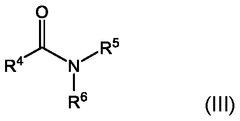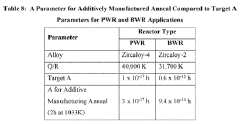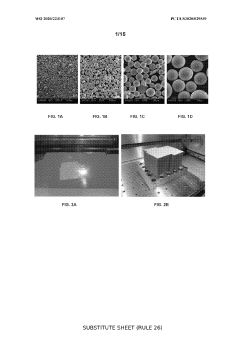Zirconia in Additive Manufacturing: Emerging Techniques
Zirconia AM Background
Zirconia, a ceramic material known for its exceptional mechanical properties and biocompatibility, has emerged as a promising candidate in the field of additive manufacturing (AM). The integration of zirconia into AM processes represents a significant advancement in materials science and manufacturing technology, offering new possibilities for creating complex, customized structures with enhanced performance characteristics.
The journey of zirconia in AM began in the early 2000s, with initial experiments focusing on the feasibility of using zirconia powders in various 3D printing techniques. These early efforts were primarily driven by the dental and medical industries, where the material's biocompatibility and aesthetic properties were highly valued. As AM technologies evolved, so did the methods for processing zirconia, leading to improved resolution, density, and overall quality of printed parts.
The development of zirconia AM techniques has been influenced by several key factors. First, the unique properties of zirconia, including its high strength, wear resistance, and chemical inertness, make it an attractive material for a wide range of applications beyond just medical and dental fields. Second, the increasing demand for customized, high-performance ceramic components in industries such as aerospace, automotive, and energy has driven research and development efforts in this area.
One of the primary challenges in zirconia AM has been achieving fully dense parts with minimal defects. Traditional sintering methods often resulted in shrinkage and warping, limiting the complexity and accuracy of printed structures. To address this, researchers have explored various approaches, including the use of binder jetting followed by sintering, stereolithography with zirconia-loaded resins, and direct ink writing techniques.
Recent advancements in zirconia AM have focused on improving the material's processability and the final properties of printed parts. This includes the development of new zirconia-based composite materials, optimization of particle size distributions for better flowability and packing density, and the implementation of advanced sintering techniques such as microwave sintering and spark plasma sintering.
The evolution of zirconia AM techniques has also been closely tied to advancements in printer hardware and software. High-resolution printers capable of handling ceramic materials with precision have been developed, along with sophisticated slicing algorithms that optimize print paths for complex geometries. These technological improvements have expanded the range of possible applications for zirconia AM, from intricate dental prosthetics to high-performance engineering components.
Market Demand Analysis
The market demand for zirconia in additive manufacturing is experiencing significant growth, driven by the material's unique properties and the expanding applications of 3D printing technologies. Zirconia, known for its exceptional strength, durability, and biocompatibility, is increasingly sought after in various industries, particularly in healthcare, aerospace, and advanced manufacturing sectors.
In the healthcare industry, the demand for zirconia-based 3D printed dental implants and prosthetics is surging. The material's biocompatibility and aesthetic qualities make it an ideal choice for dental applications, with the global dental 3D printing market expected to grow substantially in the coming years. This growth is fueled by the increasing adoption of digital dentistry and the need for customized dental solutions.
The aerospace sector is another key driver of market demand for zirconia in additive manufacturing. The material's high strength-to-weight ratio and thermal resistance properties make it valuable for producing complex components used in aircraft engines and other high-performance applications. As the aerospace industry continues to seek lightweight and durable materials, the demand for zirconia-based 3D printed parts is projected to increase.
In the field of advanced manufacturing, zirconia is gaining traction for its ability to produce high-precision components with excellent mechanical properties. Industries such as automotive, electronics, and energy are exploring the use of zirconia in additive manufacturing for creating specialized parts that require superior wear resistance and thermal insulation.
The market demand is further bolstered by the ongoing advancements in additive manufacturing technologies specifically tailored for ceramic materials like zirconia. These developments are expanding the range of possible applications and improving the quality of 3D printed zirconia parts, thereby attracting more industries to adopt this technology.
However, the market faces challenges such as the high cost of zirconia powders suitable for additive manufacturing and the complexity of the printing process. Despite these hurdles, the overall trend indicates a growing market demand as manufacturers and researchers continue to overcome these obstacles and develop more efficient and cost-effective production methods.
As sustainability becomes a key focus across industries, the ability of additive manufacturing to reduce material waste and enable on-demand production aligns well with environmental goals. This factor is expected to further drive the demand for zirconia in 3D printing applications, particularly in industries seeking to minimize their environmental footprint while maintaining high-performance standards.
Technical Challenges
The integration of zirconia in additive manufacturing (AM) presents several significant technical challenges that researchers and industry professionals are actively working to overcome. One of the primary obstacles is achieving the desired density and mechanical properties in zirconia parts produced through AM processes. The inherent porosity often found in additively manufactured ceramics can lead to reduced strength and compromised performance, particularly in high-stress applications.
Another critical challenge lies in controlling the microstructure of zirconia during the AM process. The rapid heating and cooling cycles typical in AM techniques can result in undesirable grain growth, phase transformations, and residual stresses within the material. These factors can significantly impact the final properties of the printed components, potentially leading to reduced toughness and reliability.
The development of suitable feedstock materials for zirconia AM is also a complex task. Creating powders or slurries with optimal particle size distribution, flowability, and sintering behavior is crucial for achieving consistent print quality and final part properties. Additionally, ensuring the homogeneity of the feedstock and preventing agglomeration during the printing process remains a significant challenge.
Temperature control and thermal management during the AM process pose another set of technical hurdles. Zirconia's high melting point and low thermal conductivity make it challenging to achieve uniform heating and controlled cooling rates, which are essential for preventing thermal shock and ensuring dimensional accuracy of the printed parts.
Post-processing techniques for zirconia AM parts also present challenges. Developing effective methods for removing support structures, improving surface finish, and enhancing densification without compromising the part's geometry or properties is an ongoing area of research. The need for post-sintering processes to achieve full density adds complexity to the manufacturing workflow and can introduce additional dimensional changes.
Lastly, the limited availability of AM systems specifically designed for ceramic materials, including zirconia, hinders widespread adoption and research. Most existing AM technologies are optimized for metals or polymers, necessitating significant modifications or the development of new, specialized equipment for ceramic processing. This technological gap slows down progress in the field and increases the cost of research and development efforts in zirconia AM.
Current AM Techniques
01 Zirconia synthesis and processing methods
Various methods for synthesizing and processing zirconia are explored, including sol-gel techniques, hydrothermal processes, and chemical vapor deposition. These methods aim to control the crystalline structure, particle size, and purity of zirconia for different applications.- Zirconia synthesis and processing methods: Various techniques for synthesizing and processing zirconia materials, including sol-gel methods, hydrothermal synthesis, and powder processing. These methods aim to control the particle size, crystalline structure, and properties of zirconia for different applications.
- Zirconia-based dental materials: Development of zirconia-based materials for dental applications, such as crowns, bridges, and implants. These materials offer high strength, biocompatibility, and aesthetic properties suitable for dental restorations.
- Zirconia in catalysis and fuel cells: Applications of zirconia in catalysis and solid oxide fuel cells, leveraging its unique properties such as high ionic conductivity and thermal stability. Zirconia-based materials are used as catalysts, catalyst supports, and electrolytes in various chemical processes and energy conversion systems.
- Zirconia coatings and thin films: Methods for depositing zirconia coatings and thin films on various substrates, including physical vapor deposition, chemical vapor deposition, and sol-gel techniques. These coatings provide enhanced wear resistance, thermal insulation, and corrosion protection for a wide range of applications.
- Zirconia-based composites and nanocomposites: Development of zirconia-based composite and nanocomposite materials, combining zirconia with other ceramics, metals, or polymers to achieve enhanced mechanical, thermal, and functional properties. These materials find applications in aerospace, automotive, and biomedical industries.
02 Zirconia-based dental materials
Zirconia is widely used in dental applications due to its biocompatibility and mechanical properties. Innovations in this field include improved zirconia-based ceramics for dental implants, crowns, and bridges, as well as coloring techniques to match natural tooth appearance.Expand Specific Solutions03 Zirconia in advanced ceramics and composites
Zirconia is incorporated into advanced ceramic materials and composites to enhance their mechanical, thermal, and electrical properties. These materials find applications in aerospace, automotive, and industrial sectors, offering improved durability and performance.Expand Specific Solutions04 Stabilized zirconia for high-temperature applications
Research focuses on developing stabilized zirconia materials for high-temperature applications, such as thermal barrier coatings and solid oxide fuel cells. Various stabilizing agents and processing techniques are explored to improve the material's thermal stability and performance under extreme conditions.Expand Specific Solutions05 Zirconia nanoparticles and their applications
Zirconia nanoparticles are being developed for a wide range of applications, including catalysis, sensors, and biomedical devices. Research focuses on controlling nanoparticle size, shape, and surface properties to optimize their performance in specific applications.Expand Specific Solutions
Key Industry Players
The field of zirconia in additive manufacturing is in its early growth stage, with emerging techniques driving innovation. The market size is expanding rapidly, fueled by increasing demand in industries such as aerospace, healthcare, and automotive. While the technology is still evolving, it shows promising potential for complex geometries and customized applications. Companies like Kyocera Corp., Canon, Inc., and Loughborough University are at the forefront of research and development, pushing the boundaries of zirconia-based 3D printing. The competitive landscape is characterized by a mix of established materials companies and innovative startups, with collaborations between academia and industry accelerating technological advancements. As the technology matures, we can expect to see improved material properties, faster production speeds, and wider adoption across various sectors.
Kyocera Corp.
Daiichi Kigenso Kagaku Kogyo Co., Ltd.
Zirconia AM Innovations
- A process involving the use of radiation-curable zirconia sols for additive manufacturing, allowing for the production of customized dental zirconia articles with a shiny surface, where the same zirconia material is used for glazing and coloring, applied in a gel state to achieve a durable, glossy finish.
- The method involves additively manufacturing components using zirconium alloys and subsequent high-temperature annealing within the alpha or alpha-beta phase temperature range to recrystallize the microstructure and coarsen second-phase particles, improving corrosion resistance and thermal hydraulic performance.
Material Properties
Zirconia, a ceramic material with exceptional properties, has gained significant attention in the field of additive manufacturing (AM) due to its unique characteristics. The material properties of zirconia make it particularly suitable for various AM applications, especially in industries requiring high-performance components.
One of the key properties of zirconia is its excellent mechanical strength. Zirconia exhibits high flexural strength and fracture toughness, which contribute to its durability and resistance to crack propagation. These properties make zirconia-based parts produced through AM techniques suitable for load-bearing applications and components subjected to high stress.
Thermal properties of zirconia also play a crucial role in its suitability for AM processes. The material possesses low thermal conductivity, which allows for better control of heat distribution during the manufacturing process. This characteristic is particularly advantageous in laser-based AM techniques, where precise heat management is essential for achieving desired part quality and dimensional accuracy.
Zirconia's chemical stability is another notable property that enhances its applicability in AM. The material demonstrates excellent resistance to corrosion and chemical attack, making it suitable for use in harsh environments and applications involving aggressive chemicals. This property extends the potential use of zirconia-based AM parts in industries such as chemical processing and aerospace.
The biocompatibility of zirconia is a significant advantage for medical and dental applications. The material's non-toxic nature and ability to integrate with biological tissues make it an attractive option for producing customized implants and prosthetics through AM techniques. This property, combined with zirconia's aesthetic qualities, has led to its increased adoption in dental restorations and orthopedic implants.
Zirconia's optical properties, particularly its translucency, offer unique opportunities in AM. The material can be engineered to achieve varying degrees of translucency, allowing for the production of parts with specific optical characteristics. This property is particularly valuable in dental applications, where aesthetics play a crucial role.
The wear resistance of zirconia is another property that contributes to its suitability for AM applications. Parts produced using zirconia exhibit excellent resistance to abrasion and wear, making them ideal for components subjected to friction and high-wear environments. This property extends the lifespan of zirconia-based AM parts and reduces the need for frequent replacements.
In terms of electrical properties, zirconia is an excellent electrical insulator. This characteristic makes it suitable for applications requiring electrical isolation or components in electronic devices. The combination of electrical insulation and mechanical strength opens up possibilities for creating complex, multifunctional parts through AM techniques.
Sustainability Aspects
The integration of zirconia in additive manufacturing (AM) processes presents significant opportunities for enhancing sustainability in various industrial applications. Zirconia, known for its exceptional mechanical properties and biocompatibility, offers a promising alternative to traditional materials in AM, potentially reducing environmental impact and improving resource efficiency.
One of the primary sustainability benefits of using zirconia in AM is the reduction of material waste. Traditional manufacturing methods often result in substantial material loss during the production process. In contrast, AM techniques allow for precise material deposition, minimizing waste and optimizing resource utilization. This is particularly important for zirconia, which is a valuable and energy-intensive material to produce.
The energy efficiency of AM processes using zirconia also contributes to improved sustainability. Compared to conventional manufacturing methods, AM typically requires less energy input, especially for complex geometries. This reduced energy consumption translates to lower carbon emissions and a smaller environmental footprint throughout the product lifecycle.
Zirconia's durability and longevity in AM applications further enhance sustainability by extending product lifespan. Components manufactured using zirconia-based AM techniques often exhibit superior wear resistance and mechanical strength, reducing the need for frequent replacements and minimizing the overall material consumption over time.
The localized production capabilities of AM with zirconia can significantly reduce transportation-related emissions. By enabling on-demand manufacturing closer to the point of use, the need for long-distance shipping of finished products or components is diminished, leading to a more sustainable supply chain model.
Furthermore, the ability to create complex, lightweight structures through AM with zirconia opens up new possibilities for design optimization. This can lead to more efficient products, such as lighter aerospace components or more effective medical implants, which in turn contribute to reduced energy consumption and improved performance in their respective applications.
However, it is crucial to consider the entire lifecycle of zirconia-based AM products to fully assess their sustainability impact. This includes evaluating the sourcing of raw materials, energy consumption during production, and end-of-life recycling or disposal options. As the technology evolves, developing efficient recycling methods for zirconia AM products will be essential to close the loop and maximize sustainability benefits.
In conclusion, the integration of zirconia in AM techniques offers significant potential for enhancing sustainability across various industries. By reducing waste, improving energy efficiency, extending product lifespans, and enabling innovative designs, zirconia-based AM processes contribute to a more sustainable manufacturing paradigm. Continued research and development in this field will be crucial to fully realize these sustainability benefits and address any remaining challenges.







